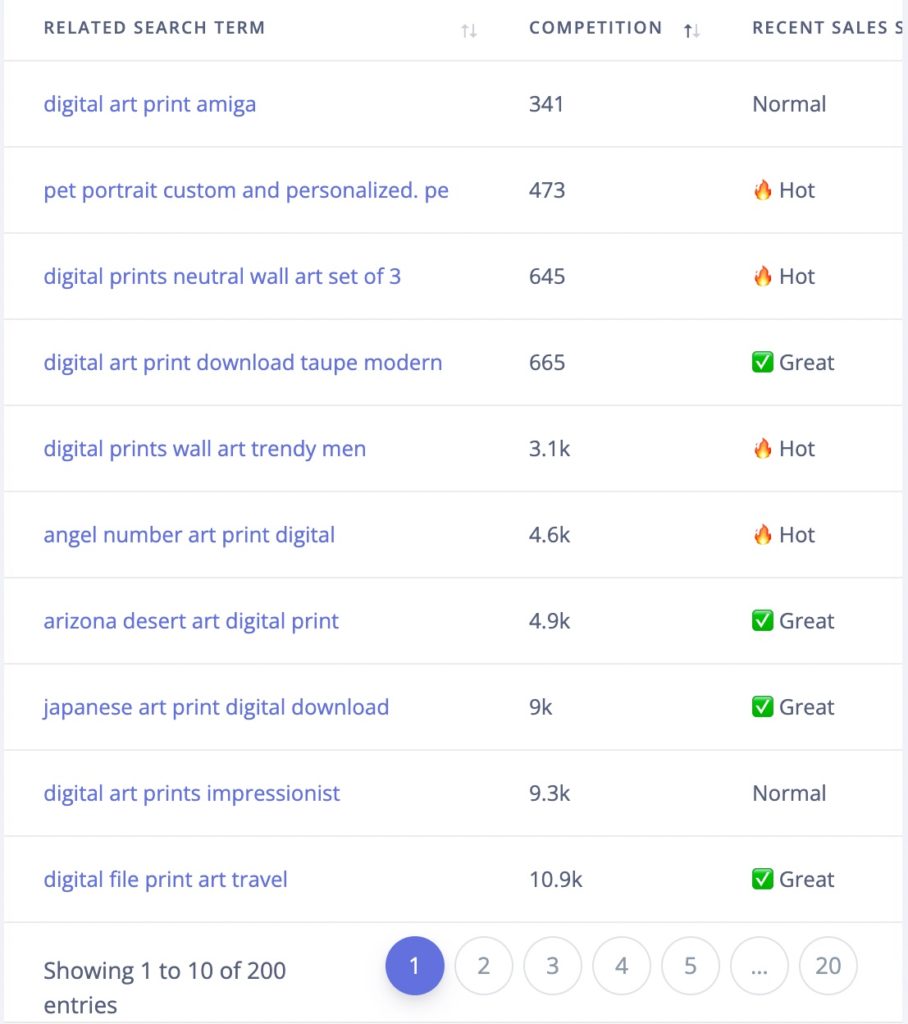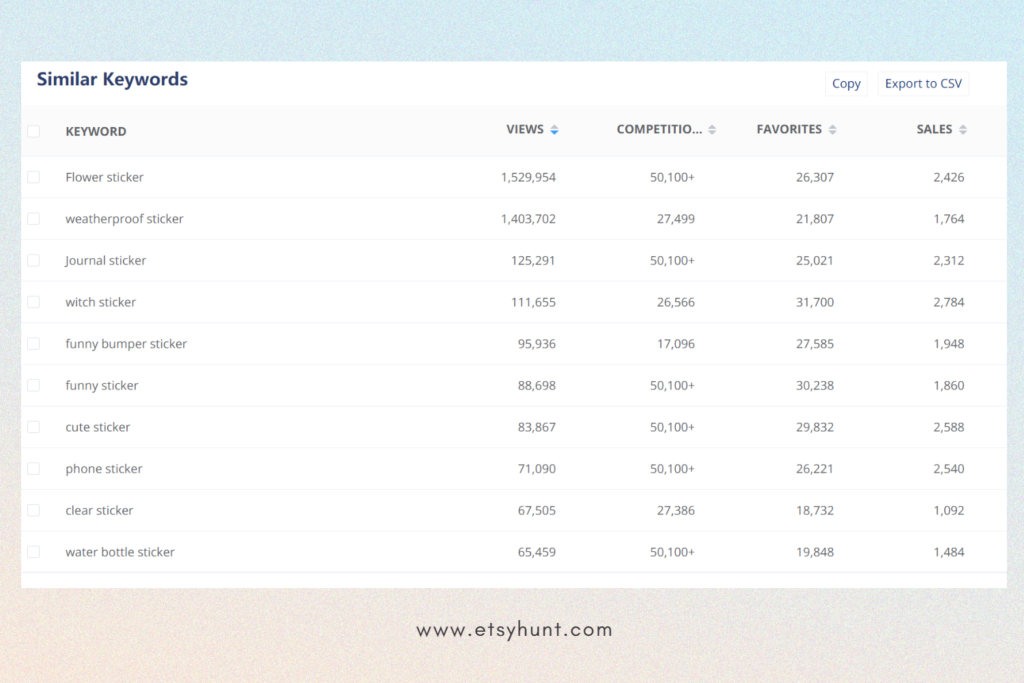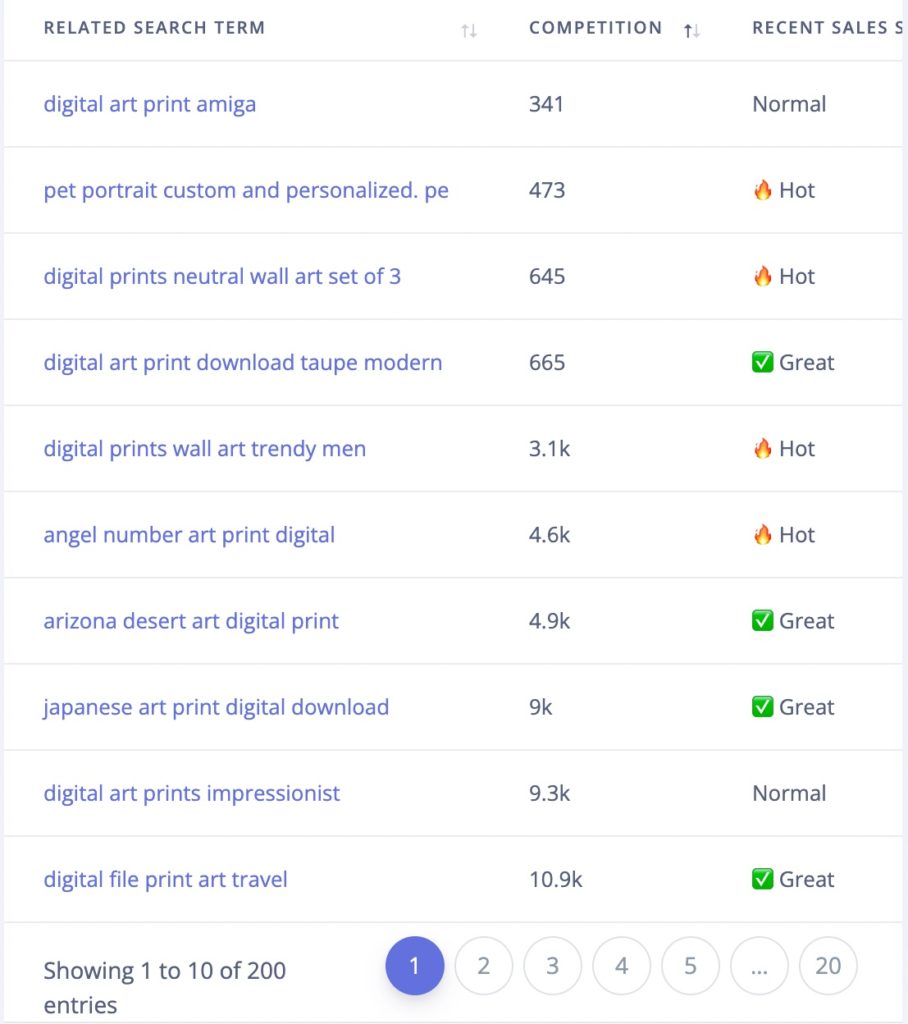Are you looking to gain a competitive edge in the bustling marketplace of Etsy? If so, it’s crucial to optimize your listings with the right keywords. Finding the best keywords for your Etsy shop can be a game-changer, as it directly influences your shop’s visibility in search results. In this article, we will explore various strategies and techniques that will help you uncover the most effective keywords for your Etsy shop, ensuring that your products get the attention they deserve and ultimately boost your sales. So, let’s dive right in and discover the secrets to finding the best keywords for your Etsy shop!
Understanding Etsy’s Search Algorithm
If you’re an Etsy seller, you know that getting your products seen by potential customers can be a challenge. That’s where Etsy’s search algorithm comes in. Understanding how this algorithm works is crucial for optimizing your listings and gaining visibility on the platform.
Why keywords are important on Etsy
Keywords are the foundation of Etsy’s search algorithm. When a buyer searches for a specific item, Etsy’s algorithm looks for listings that match the keywords they used. By including relevant keywords in your listings, you increase the chances of your products appearing in search results.
How Etsy’s search algorithm works
Etsy’s search algorithm takes multiple factors into consideration when determining the visibility of a listing. These factors include the relevance of keywords, customer preferences, listing quality, and seller performance. By understanding how these factors influence the algorithm, you can strategically optimize your listings to improve their visibility.
Factors that influence Etsy’s search algorithm
While Etsy doesn’t disclose the exact details of its search algorithm, there are several known factors that play a role in determining search rankings. These factors include keywords in the title and description, customer reviews and engagement, listing freshness, conversion rates, and the use of Etsy’s tags and attributes. By optimizing these factors, you can increase your chances of appearing higher in search results.
Keyword Research Basics
Keyword research is the foundation of any successful Etsy SEO strategy. By identifying the right keywords to target, you can improve the visibility of your listings and reach your target audience effectively.
Identify your target audience
Before diving into keyword research, it’s important to identify your target audience. Understanding who your potential customers are will help you tailor your keyword strategy to their needs and preferences. Consider factors like demographics, interests, and buying behaviors to paint a clear picture of your target audience.
Brainstorm potential keywords
Once you have a clear understanding of your target audience, it’s time to brainstorm potential keywords. Start by thinking about the words and phrases that buyers might use when searching for products like yours. Put yourself in their shoes and consider both broad and specific keywords that relate to your products.
Use keyword research tools
To take your keyword research to the next level, consider using keyword research tools. Tools like Google Keyword Planner, Moz’s Keyword Explorer, and EtsyRank can provide valuable insights into keyword search volume, competition, and related keywords. By using these tools, you can uncover hidden gems and discover keywords that have the potential to drive traffic to your listings.
Analyze competitor keywords
Another effective strategy for keyword research is analyzing competitor keywords. Take a look at the keywords used in the listings of top-performing shops in your niche. This can give you a sense of the keywords that are working well and help you identify gaps or opportunities in your own keyword strategy.

Long-Tail vs. Short-Tail Keywords
When it comes to keyword strategy, it’s important to understand the difference between long-tail and short-tail keywords. Both have their benefits and understanding how to balance them can give you an edge in Etsy’s search algorithm.
Difference between long-tail and short-tail keywords
Short-tail keywords are broad and general terms that encompass a wide range of products. For example, “jewelry” would be considered a short-tail keyword. On the other hand, long-tail keywords are more specific and usually consist of multiple words. An example of a long-tail keyword would be “handmade silver necklace.”
Benefits of using long-tail keywords
While short-tail keywords may have higher search volume, they also have higher competition. Long-tail keywords, on the other hand, have lower search volume but also lower competition. By targeting long-tail keywords, you can reach a more specific audience that is more likely to convert into customers.
Balancing short-tail and long-tail keywords
Finding the right balance between short-tail and long-tail keywords is key for a successful Etsy SEO strategy. While it’s important to include some short-tail keywords to capture a broader audience, focusing on long-tail keywords can help you stand out and reach customers looking for specific products. Experiment with different combinations of keywords to find the optimal balance for your listings.
Using Etsy’s Autocomplete Feature
Etsy’s autocomplete feature is a powerful tool for generating keyword ideas and understanding what buyers are searching for. By utilizing this feature, you can gain valuable insights into popular search terms and optimize your listings accordingly.
How Etsy’s autocomplete feature works
When a buyer starts typing a search query on Etsy, the autocomplete feature suggests popular keywords and phrases related to their search. These suggestions are based on real-time search data from other buyers on the platform. By paying attention to these suggestions, you can get a sense of the search trends and preferences of Etsy’s user base.
Utilizing autocomplete for keyword ideas
To leverage Etsy’s autocomplete feature, start by typing in a few relevant keywords related to your products. Take note of the suggestions that appear and consider incorporating them into your listings. These suggestions can give you valuable insights into what buyers are searching for and help you optimize your listings for those specific keywords.
Analyzing autocomplete suggestions
In addition to generating keyword ideas, analyzing Etsy’s autocomplete suggestions can provide insights into popular niches and trends. Pay attention to recurring keywords and phrases that appear frequently in the autocomplete suggestions. This can give you an idea of what products or categories are in high demand and help you tailor your keyword strategy accordingly.

Utilizing Etsy’s Tags and Attributes
Etsy’s tags and attributes are additional fields where you can include relevant keywords to further optimize your listings. Understanding how to effectively use these fields can help you improve the visibility of your products in search results.
Understanding the importance of tags
Tags are descriptive keywords or phrases that help categorize your products and make them more discoverable. Etsy allows sellers to include up to 13 tags per listing. When choosing tags, consider both broad and specific keywords that accurately describe your products. Be sure to use tags that are relevant to your target audience and align with the keywords you have identified through your research.
Choosing relevant attributes
Alongside tags, Etsy provides sellers with attribute fields to further describe their products. Attributes are specific characteristics of your products that can help buyers filter their search results. By choosing relevant attributes that align with your products, you can ensure your listings appear in front of buyers who are specifically looking for those features.
Using descriptive and specific keywords
When filling out your tags and attributes, it’s important to use descriptive and specific keywords. Instead of using generic terms, try to be as specific as possible to target your ideal customers. For example, instead of using “necklace,” you could use “handmade sterling silver necklace with gemstone pendant.” This helps narrow down your audience and ensures that your listings are seen by buyers who are actively searching for products like yours.
Avoiding keyword stuffing
While it’s important to include relevant keywords in your tags and attributes, it’s essential to avoid keyword stuffing. Keyword stuffing refers to the practice of overloading your listings with excessive keywords in an attempt to manipulate search rankings. This can have a negative impact on your visibility and may even result in penalties from Etsy. Focus on incorporating keywords naturally and organically to provide a positive user experience for your potential customers.
Optimizing Titles and Descriptions
Titles and descriptions are two key elements of your listings that can greatly impact your visibility on Etsy. By optimizing these sections with relevant keywords, you can improve your chances of appearing in search results and attracting potential customers.
Crafting keyword-rich titles
When creating titles for your listings, it’s important to include relevant keywords that accurately describe what you’re selling. Start with your primary keyword, the one that best represents your product, and incorporate additional keywords that are highly relevant. Aim for a concise and clear title that provides both information and entices potential buyers to click on your listing.
Writing compelling descriptions with keywords
Descriptions are an opportunity to provide more information about your products and convince buyers to make a purchase. Include your primary keywords in the first few sentences of the description to ensure they are immediately visible to both buyers and search engines. Throughout the description, incorporate additional keywords in a natural and informative way. Be sure to highlight the unique features and benefits of your products to capture the attention of potential buyers.
Strategic placement of keywords
When optimizing your titles and descriptions, strategic placement of keywords is key. While it’s important to include keywords, avoid keyword stuffing and prioritize readability. The goal is to provide valuable and engaging content for potential buyers, not to overload your listings with keywords. Aim for a balance between readability and keyword optimization to maximize the effectiveness of your listings.
Leveraging Google Keyword Planner
Google Keyword Planner is a powerful tool that can provide valuable insights into keyword search volume and competition. By utilizing this tool, you can uncover popular Etsy keywords and optimize your listings accordingly.
Using Google Keyword Planner tool
To start using Google Keyword Planner, create an account on Google Ads and access the Keyword Planner tool from the Tools & Settings menu. Enter relevant keywords related to your products and explore the suggestions provided by the tool. Take note of the average monthly searches and competition level for each keyword to guide your optimization efforts.
Finding keyword search volume and competition
Google Keyword Planner provides data on the average monthly searches for specific keywords as well as the level of competition. This data can give you an idea of the popularity of certain keywords and help you identify keywords with high search volume and low competition. By leveraging these insights, you can target keywords that have the potential to drive traffic to your Etsy listings.
Identifying popular Etsy keywords on Google
In addition to providing insights on search volume and competition, Google Keyword Planner can also help you identify popular Etsy keywords that are frequently searched on Google. Expand your keyword research efforts by exploring the keyword suggestions provided by the tool. Look for keywords that have a high search volume on Google, as these are likely to be popular on Etsy as well.
Analyzing Etsy’s Search Terms Report
Etsy provides sellers with a Search Terms Report that can give valuable insights into the performance of their keywords. By analyzing this report, you can identify top-performing keywords and optimize your listings accordingly.
Accessing the Search Terms Report
To access the Search Terms Report, navigate to your Etsy shop dashboard and click on “Stats.” From there, select “Search Terms” under the “Traffic” section. This report provides a list of all the search terms that led buyers to your shop.
Identifying top-performing keywords
Analyze the data in the Search Terms Report to identify the keywords that are driving the most traffic to your shop. Look for keywords that have a high click-through rate and conversion rate. These are the keywords that are resonating with your target audience and leading to sales. Once you’ve identified the top-performing keywords, consider incorporating them into your titles, descriptions, tags, and attributes.
Identifying underutilized keywords
In addition to identifying top-performing keywords, the Search Terms Report can also reveal underutilized keywords. These are keywords that are driving traffic to your shop but may not be heavily targeted by your competitors. Capitalize on these opportunities by optimizing your listings for these keywords and potentially gaining a competitive advantage in the Etsy marketplace.
Experimenting and Monitoring Results
Etsy SEO is not a one-time effort; it requires continuous experimentation and monitoring of results. By conducting A/B tests with different keywords and using analytics to track keyword performance, you can refine your keyword strategy and maximize your listing visibility.
A/B testing with different keywords
To determine which keywords are most effective for your listings, conduct A/B tests by creating multiple variations of your listings with different keywords. Monitor the performance of each variation, paying attention to factors like click-through rate, conversion rate, and overall visibility. This will help you identify the keywords that resonate most with your target audience and optimize your listings accordingly.
Using analytics to track keyword performance
Etsy provides sellers with a range of analytics tools that can help you track the performance of your listings. Monitor metrics like views, favorites, and sales for each listing and analyze how changes in your keyword strategy impact these metrics. By tracking keyword performance, you can make data-driven decisions and continually refine your keyword strategy to improve your listing visibility and drive sales.
Adjusting and refining keyword strategy
Based on the results of your experiments and the insights gained from analytics, make adjustments and refinements to your keyword strategy. This could involve tweaking your titles and descriptions, experimenting with different combinations of keywords, or targeting new keywords based on emerging trends. Etsy’s search algorithm is dynamic, so it’s important to stay flexible and adapt your strategy to stay ahead of the competition.
Staying Up-to-Date with SEO Trends
SEO is an ever-evolving field, and it’s important to stay up-to-date with the latest trends and best practices. By following SEO blogs and forums, keeping an eye on Etsy’s updates, and adapting to changes in search optimization, you can maintain a competitive edge and continuously improve your Etsy SEO strategy.
Following SEO blogs and forums
There are numerous SEO blogs and forums where experts share their insights and tips on optimizing listings for search engines. By following these blogs and forums, you can stay up-to-date with the latest trends, algorithm updates, and best practices in the SEO world. Consider subscribing to newsletters or joining communities where you can engage with other sellers and learn from their experiences.
Keeping an eye on Etsy’s updates
Etsy regularly updates its platform and search algorithm to improve the user experience and provide better results for buyers. Stay informed about these updates by following Etsy’s official announcements, blog posts, and social media channels. These updates can provide valuable insights into changes in the algorithm and help you adapt your SEO strategy accordingly.
Adapting to changes in search optimization
As search optimization techniques evolve, it’s important to adapt your keyword strategy to stay ahead of the competition. Be open to trying new approaches, testing different keywords, and analyzing the results. By staying proactive and continually refining your SEO strategy, you can improve your listing visibility, attract more customers, and ultimately grow your Etsy business.
In conclusion, understanding Etsy’s search algorithm and implementing an effective keyword strategy is essential for standing out in the crowded Etsy marketplace. By conducting thorough keyword research, utilizing Etsy’s features and tools, optimizing your titles and descriptions, leveraging external tools like Google Keyword Planner, analyzing Etsy’s Search Terms Report, experimenting with different keywords, and staying up-to-date with SEO trends, you can improve your Etsy listings and gain a competitive advantage. Remember, it’s a continuous process, so keep refining your keyword strategy and adapting to the evolving landscape of search optimization. Good luck with your Etsy SEO journey!



